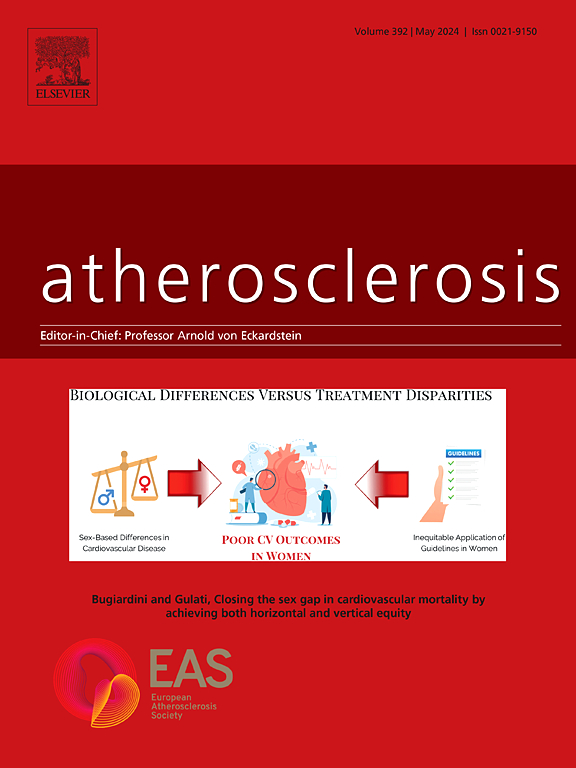运动调节的microrna对动脉粥样硬化的保护作用
IF 5.7
2区 医学
Q1 CARDIAC & CARDIOVASCULAR SYSTEMS
引用次数: 0
摘要
心血管疾病仍然是世界范围内死亡的主要原因,动脉粥样硬化(AS)是一个关键的潜在病理过程和主要危险因素。有规律的体育锻炼被广泛认为是降低as风险和严重程度的有效策略,但运动发挥其保护作用的确切分子机制仍未完全了解。MicroRNAs (miRNAs)是基因表达的关键调控因子,通过影响血管功能、脂质代谢和炎症在AS的进展中发挥着不可或缺的作用。运动诱导的AS改善是一个复杂的过程,mirna不仅在细胞和组织中发挥重要作用,而且作为一种新的信号分子在血液中稳定循环。这些循环的mirna介导器官和组织之间的交流,作为潜在的生物标志物,可以为运动的代谢益处提供更深入、更系统的见解。在这篇综述中,我们探讨了我们对运动如何影响细胞内和循环mirna的理解的最新进展。我们强调运动调节的mirna如何促进内皮功能,促进各种代谢器官的脂质代谢,减少单核细胞介导的全身性炎症,同时也解决了它们在缓解虚弱中的作用。循环mirna动态反映组织对运动的特异性反应,有望成为as的诊断和预后生物标志物。此外,我们还讨论了该领域的挑战和未来方向,旨在揭示运动诱导的miRNA调节如何为预防和治疗AS提供创新的治疗策略。本文章由计算机程序翻译,如有差异,请以英文原文为准。

Atheroprotective roles of exercise-regulated microRNAs
Cardiovascular disease remains the leading cause of death worldwide, with atherosclerosis (AS) serving as a critical underlying pathological process and major risk factor. Regular physical exercise is widely recognized as an effective strategy to reduce the risks and severity of AS, yet the precise molecular mechanisms through which exercise exerts its protective effects are still not fully understood. MicroRNAs (miRNAs), key regulators of gene expression, play integral roles in the progression of AS by influencing vascular function, lipid metabolism, and inflammation. The exercise-induced improvement of AS is a complex process, with miRNAs playing essential roles not only within cells and tissues but also circulating stably in the bloodstream as novel signaling molecules. These circulating miRNAs mediate communication between organs and tissues, acting as potential biomarkers that could provide deeper, systemic insights into the metabolic benefits of exercise. In this review, we explore recent advancements in our understanding of how exercise affects both intracellular and circulating miRNAs. We emphasize how exercise-regulated miRNAs contribute to endothelial function, promote lipid metabolism across various metabolic organs, and reduce monocyte-mediated systemic inflammation, while also addressing their role in alleviating frailty. Circulating miRNAs, which dynamically reflect tissue-specific responses to exercise, hold great promise as diagnostic and prognostic biomarkers for AS. Moreover, we discuss the challenges and future directions in this field, aiming to uncover how exercise-induced miRNA modulation could offer innovative therapeutic strategies for the prevention and treatment of AS.
求助全文
通过发布文献求助,成功后即可免费获取论文全文。
去求助
来源期刊

Atherosclerosis
医学-外周血管病
CiteScore
9.80
自引率
3.80%
发文量
1269
审稿时长
36 days
期刊介绍:
Atherosclerosis has an open access mirror journal Atherosclerosis: X, sharing the same aims and scope, editorial team, submission system and rigorous peer review.
Atherosclerosis brings together, from all sources, papers concerned with investigation on atherosclerosis, its risk factors and clinical manifestations. Atherosclerosis covers basic and translational, clinical and population research approaches to arterial and vascular biology and disease, as well as their risk factors including: disturbances of lipid and lipoprotein metabolism, diabetes and hypertension, thrombosis, and inflammation. The Editors are interested in original or review papers dealing with the pathogenesis, environmental, genetic and epigenetic basis, diagnosis or treatment of atherosclerosis and related diseases as well as their risk factors.
 求助内容:
求助内容: 应助结果提醒方式:
应助结果提醒方式:


